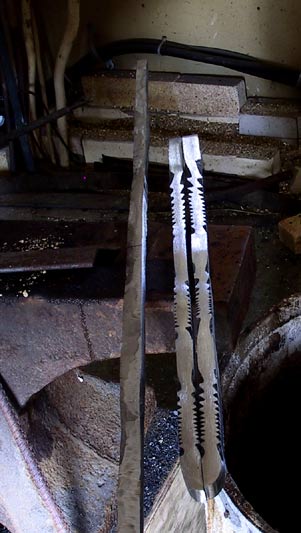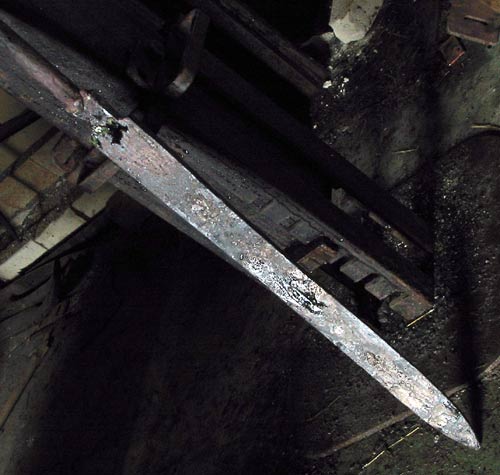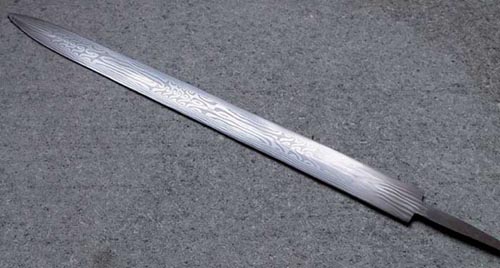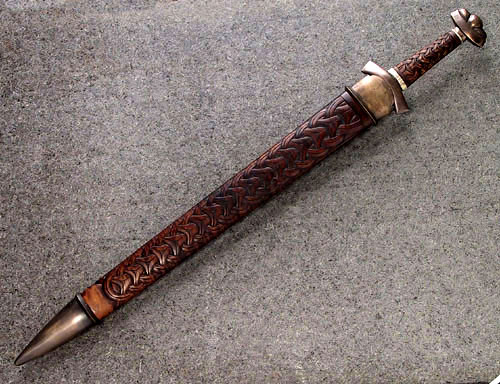This is a tutorial I did in 2003. It was the first composite pattern welded sword I made and I can still remember the nervous excitement of planning the project. I received a grant from my local arts funding organization (Arts NB) to give me the time to make the project happen. I’ve learned allot since I wrote this tutorial almost ten years ago, but I think it gives you an idea of how the process of pattern welding works and it’s a record of how I made my first pattern welded sword. Enjoy 🙂
Jake
the Blade construction is made of three billets of laminated steel. This is a picture of the initial forge welding of the edge billet which has twelve layers of alternating 1084 and L6 steel. when struck at high heat, steel will form a molecular bond and fuse together.
Once the billet is welded, I draw it out using the hydrolic press and my 6 pound sledge hammer until it is long and square. This is the edge billet that will wrap all the way around the two central billets, so it is roughly four feet long when I am done drawing it out.
the two central billets (pictured on the right of the above photo) are twisted to mirror each other, this is called an alternating twist pattern and was popular with Anglo-Saxon and Viking smiths from the Migration Era to the Viking Age. The edge billet is pictured at the left of the two twisted central billets. All the billets have been ground so that they will weld together without forming scale inclusions.
this is a sketch to show you what the steel pattern looks like under the fire scale.
I have now wrapped the edge billet around the edge of the two central billets. It is secured with a steel collar that I forged into shape and then hammered in place; this holds the three billets together using tension. I have begun to forge weld the tip of the sword billet, so that all three billets will be fused together into one solid sword blade.
The blade has been successfully forge welded together into a single piece of steel. I’ll now forge it to shape and begin the grinding and polishing process. Then I will heat-treat the blade to make it tough and durable. Once that is done I will finish polishing it and etch it to bring out the pattern created by this elaborate pattern welding process.
Here is the blade once I have done an initial etch to see how the pattern turned out. you can see the swirls in the pattern where the central billets are twisted to mirror each other.
In this picture you can see where the edge billet which is twelve layers of laminated steel wraps around the tip of the blade (around the two twist billets).
Now I have to construct the hilt and scabbard and the fittings for them.
I construct the models for the fittings out of wax, then I make a wax ‘tree’ of sprews and encase it in plaster. I steam the wax models out so that they leave the cavity of the mold empty in the negative shape of them. Then I pour molten bronze into this mold and brake the mold away, revealing the bronze hilt and scabbard fittings(below)
Once I have broken the bronze castings out of the mold there is quite a bit of finishing to do, I have to remove flashing where the molten bronze flowed into tiny cracks in the plaster and I have to remove the fittings from the spews which are the avenues that the bronze flowed down to fill the mold.
Once I have carved and coloured the wooden scabbard and grip I have to fit the spacers of antler and leather and make sure that the bronze furniture fits together snugly on the blade.
Once I am satisfied that I have a precision fit I epoxy the fittings on and peen the tang to hold the hilt firmly in place.
On this piece I also scrimshawed Nordic Runes on the spacer above the guard before I finished the hilt assembly. the Runic inscription says Heimdall on one side and Bifrost on the other. Heimdall is the gate keeper of the Gods in the ancient Norse mythology, and Bifrost is the rainbow bridge that spans between Midguard the land of mortal humans and Asgard the land of the Gods.
The sword is now photographed and packed to be shipped off to Denmark where it’s new owner is eagerly awaiting it.





















hey i really admier your work from seeing what youv made i realeys that iv only just taped the surface of pattern welding and was wondering if you could give me some guidanse on the topic.
Hi Chris, thanks, A good place to learn more about pattern welding is the Bladesmith’s forum if you read the back topics there is a lot of information on the subject – http://forums.dfoggknives.com/index.php?act=idx
It’s gorgeous.
It fantastic! But, I was hoping for a little more detail. For example, how was the twisting done? Does the sword have a lot of flexability? Bronze wasn’t often found in Viking tombs… Though I think for lost-wax casting its a good choice.
How do you peen a tang?
Hi there, the twisting was done by clamping the bar in a vice and twisting is with a set of modified vise-grips with a handle on both sides. Yes the sword is flexible, as flexible as a mono-steel blade. Peening a tang is the same as riveting. you cut the tang so that it protrudes about half of it’s diameter above the pommel then forge it down in small circles with a ball peen hammer until the edges spread out and touch the pommel.
I really enjoyed reading about this blade, can yo get an even twist all the way down the blade so the pattern goes from hilt to tip? And what would be the effect if this was made into a blade with a wide fuller, have you any examples of work you’ve done similar to my query?
Thanks t. you can do an uninterrupted twist, it looks like the twisted sections but all the way down the blade. I tend to do interrupted twists because I like the way they look, but I’ve done some full twists on seaxes. If you’re interested in viking pattern-welding I recommend you look up the book “Swords of the Viking Age” by Ian Pierce, lots of examples of different types of pattern welding there.
Mr. Powning you now have an emai address to reach me. I would invite you to contact me. I have some ” musings ” of my own you may find interesting.
Thank you, Todd
Many are called, few are chosen.
hello, I am thinking about getting a gas forge. What kind would you recommend for a boy who makes 50 a week?
Also, I know how busy you must be. I would really like to have a mentor to teach me the ins and outs of old blacksmithing.
Thanks for taking the time to read this,
Teeps
Your blade looks incredible. I would be very interested in purchasing one. Can you please advise the details?
I really like this tutorial, but I would like some clarification. Now my billet welds are not bad, I have done probably six or seven of various layers but never one consisting of multiple billets. The tip of the blade, where the long four foot section wraps around… This weld scares me. What kind of hammer blows do you use to get the part that wraps around to weld properly. In my experience something like this would be prone to slipping around when your hammering, pulling apart welds. Do you hit it from every angle or does it kind of by some magic principle just weld by the pressure of hitting it from the top and bottom like a normal billet. Seriously I have lost sleep over this, any help would be great.
Hi Jordan,
There are a couple ways you can do the tip weld. The simplest is to wrap the edge billet around the blade, secure it with collars or iron wire then flux and heat the tip to welding heat. Once the tip it ready to weld draw it out of the forge and bang it strait down onto the floor several times. this welds the tip portion, heat it up again and repeat then begin working the weld back on the anvil.
The other option is to use an iron form or swage block, heat the billet, then place the heated tip in the swage and hammer the tang end of the core forcing it into the tip wrap where it is confined by the swage. I hope that helps!
Yes that should help. Still sounds like it could be a difficult weld, but at least now I have a tried and tested strategy. I assume you don’t absolutely smash it down on the floor then, more like a series of light to medium hits? Say If I were trying to upset similar stock, would I hit it lighter than that? Honestly I think I will try the swage block method either way, if you think it would be more successful, though I may need to make a custom swage that isn’t much concern. Thanks a lot though! great help
Your work is so beautiful and inspiring that my chest becomes tight to even think of it. These pieces fuel my passion like nothing else and yet drive me to despair that I may never reach such heights of mastery. I wish nothing more than to one day have the ability to create in the same manner as yourself and until then, I fully intend to gain my own experience. If you have any words of wisdom for a young apprentice such as myself, I would rejoice to hear them! Any advice on where to learn more about different metals for smithing would be especially appreciated. Thank you for making your work public.
Perfect. Absolutely beautiful.